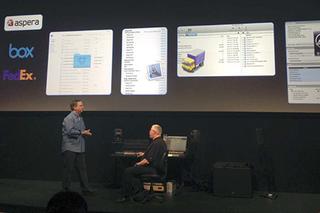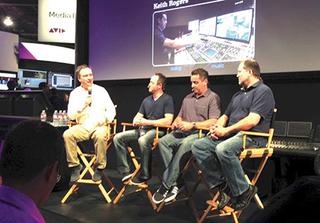The Pro Tools 12 Update Conundrum
Pro Tools is the most ubiquitous digital audio workstation in use for audio production and also the one that generates the most controversy. Most of this stems from the fact the program is owned by Avid, a company with a long history of making decisions that exasperate its user base.
The 2015 NAMM release of Pro Tools 12 announced a version with no significant new features, leaving users scratching their heads about whether they should upgrade. With the 2015 NAB Show approaching, Tom Graham, Avid Worldwide Pro Audio and Pro Segment marketing manager contacted me to set up a meeting to discuss Pro Tools 12 at the show.
What follows was gleaned from my discussion with Graham, some time spent with Gil Gowing, manager for Avid’s Pro Audio Solutions Specialists-Americas on the NAB Show floor, NAB Show demos, and the audio sessions at Avid Connect. Hopefully this information helps clear up some of the confusion surrounding this release and gives a clearer picture of Avid’s direction for the software.
FEATURES AND IMPROVEMENTS

Tom Graham and Gil Gowing demonstrate Avid Cloud Collaboration at the 2015 NAB Show.
Features making their debut in Pro Tools 12 are subscription and service options, the Avid Application Manager, the ability to locate and install plug-ins from within the program while it’s running, a new monitor path setting that insures the monitoring paths move from machine to machine, and the Metadata Inspector.
Improvements include Dashboard (to replace Quick Start), down and upmixing of outputs, and all-around bussing and I/O improvements. The ability to install plugins while Pro Tools is open, and built-in down-and upmixing could prove very useful, but most of the features in this first pass of version 12 seem more iterative than generational. Avid says we’re only seeing the tip of the iceberg and that this version is aimed at getting users onto their new platform, actually allowing a faster method of delivering enhancements and fixes to the software.
Graham pointed out that the traditional release cycle for software is about 18 months and includes bug fixes and new features and moving to the new modelwill change that. The new Avid platform looks similar to the Adobe model where software patches and new features are released to users as they become available. Users can control how and when updates are applied using the Application Manager and previous version installers will be available from the Avid website if the software needs to be rolled back.
Installing version 12 removes version 11 from the machine, unless you rename the application to Pro Tools 11.3.1 for instance to keep both versions. Licenses for versions 10 and 11 are included with upgrades. Version 10 can also be installed alongside. 11 and 12 keep compatibility with older plug-ins.
Collaboration, the feature everyone anticipated would be in Pro Tools 12, remains unreleased as of the NAB Show. There were demos of Collaboration at the show, but they were all done over a local network with no long distance contribution and no video or text chat. These demos consisted mostly of sending tracks back and forth with some “post-as-frozen” examples. Things did not always work smoothly, hinting that Collaboration is not quite ready, but likely isn’t far off.
The most compelling argument made for Collaboration came from the sound crew for the television show “Person of Interest.” This large crew works from multiple locations and typically has more than 300 tracks of audio in each show. They said the most challenging part of their workflow is managing the changes caused by editorial and visual effects changes made throughout the production process. This team could actually benefit from collaborative tools that smooth out their workflow, yet their needs also highlight just how far Avid has to go to achieve their collaboration goals.
Media Composer and Pro Tools still don’t have seamless integration, which is necessary if the entire production team is meant to work together collaboratively. True cross-team collaboration won’t happen until this long-standing issue between Avid’s two core software products is ironed out.
Pro Tools 12 also signals the rollout of Avid Cloud, which is getting is first workout through the cloud-reliant Pro Tools | First. Avid Cloud includes storage, as well as the Artist Community and Marketplace, which are interesting because they give users the ability to market themselves and get paid. Future components of Avid Cloud include Collaboration and a private version of Marketplace that allows asset protection and sharing among creative teams.
DECISIONS, DECISIONS

The “Person of Interest” sound team talks about collaboration with Tom Graham at the NAB Show.
The primary reason for the release of Pro Tools 12 is that Avid wants everyone on a subscription or upgrade plan by the end of 2015. All current users are expected to upgrade their existing software or purchase a subscription or upgrade plan before Jan. 1, 2016 in order to continue receiving new versions of Pro Tools, otherwise their software will be frozen at the version current as of Dec. 31, 2015.
Upgrading Pro Tools after a license is frozen requires either a new license or a new subscription purchase; the previous perpetual license will no longer be eligible for upgrades. There actually is some level of support included with all of the options, but they are really annual software subscription up-to-date plans. Support plans for HD systems were still in development as of the NAB Show, but HD users are still expected to upgrade to version 12 before the end of 2015 to remain current.
Deciding on the move to Pro Tools 12 really comes down to whether you want or need the tools that have been announced and whether you want to stay up-to-date with Pro Tools past the version you’re currently using.
The collaboration features look like a potential winner for large organizations, and Marketplace, with its social media features, may offer individuals the opportunity to build their personal brand. Those who choose not to upgrade or purchase by the end of 2015 can continue using their existing systems just as they do today, but without any new features Pro Tools may gain as it continues to mature. Thankfully, we all have a little time to make up our minds.
Editor's note: Pro Tools 12.1 was released on July 1 with significant enhancements.
Jay Yeary is a Pro Tools owner/user and a media engineer specializing in audio. He is an AES Fellow and is a member of both SBE and SMPTE. He can be contacted through TV Technology magazine.
Get the TV Tech Newsletter
The professional video industry's #1 source for news, trends and product and tech information. Sign up below.
